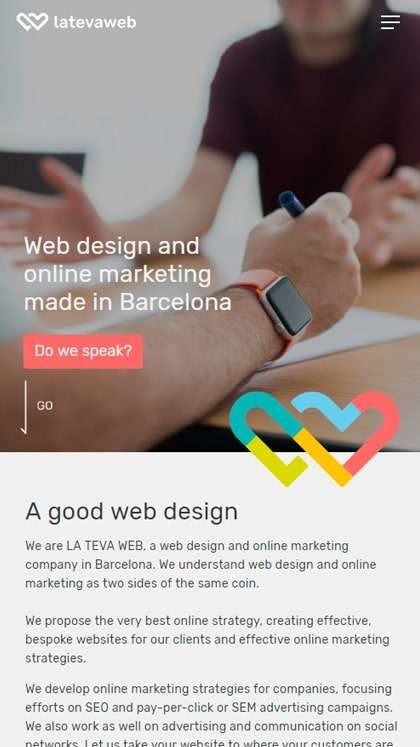Out of the 7.33 billion mobile device users worldwide, 61% of mobile searchers are more likely to contact a local business with a mobile-friendly site. Many people use mobile devices to find content and research products/services, which indicates the growing need for mobile-friendly and mobile-first sites.
This article explains what mobile-first design is, why it is important, its key elements, and the difference between mobile-first and responsive design.
Table of Contents
What Is Mobile-First Design?
Design for mobile first aims to create the best user experience (UX) for people visiting websites via smartphones. By building a website prioritizing smartphone and tablet users, web designers and developers can help achieve a seamless experience for these visitors.
With a mobile-first design, the process starts with creating a website or application optimized for mobile devices and then scaling up to larger screens, rather than starting with a desktop design and trying to adapt it to mobile devices.
Since mobile devices have become the primary way people access the internet, designing for mobile first ensures that users on smaller screens have a seamless and intuitive experience. Working with the best IT service providers can be crucial for successfully implementing a mobile-first design strategy.
Mobile-first design typically involves simplifying the layout, using responsive design techniques to ensure that the website or application looks good on any screen size, and focusing on the most important content and functionality.
5 Best Practices in Mobile-First Web Design
- Place Your Users at the Forefront of Your Design
- Establish the Visual Hierarchy of Your Content
- Keep Your Website Simple
- Make CTAs and Other Mobile-First Elements Consistent and Bold
- Work on Your Site’s Loading Speed
People who use your website or app on mobile and experience poor UX are 62% less likely to buy something from you in the future, even if you have attractive and data-driven marketing campaigns. That’s the difference a well-designed website makes.
To ensure your website’s poor design doesn't turn away customers, follow these mobile-first design best practices to improve the quality of your mobile-first website:
1. Place Your Users at the Forefront of Your Design
Mobile-first designs start with research and identifying your visitors’ pain points. A mobile-first website should help visitors complete a task or solve a problem quickly and efficiently.
Determine what user flows and user journeys to implement on your mobile-first website. Consider different user behavior scenarios on each site page and adjust your user’s journey accordingly.
To make your website more user-friendly and intuitive, think about the possible interactions between a user and a website interface and identify your users’ pain points by:
- Researching and analyzing your competitor’s mobile-friendly solutions
- Asking your visitors directly about the issues they are experiencing with your mobile website through surveys
2. Establish the Visual Hierarchy of Your Content
Content for a mobile-first website should be as concise and to the point as possible. Avoid fluff, clutter, and any other unnecessary content that could distract or overwhelm the user or make the content hard to read.
Mobile websites come with certain screen size constraints; therefore, present content to your audience in a way that respects the visual hierarchy according to the importance of content. You will easily discern which elements are most important and should be placed first.
Content optimization improves website performance and facilitates UX. It also makes the website more accessible and ADA-compliant.
Regarding mobile-first content and its hierarchy, follow these best practices:
- Keep titles on top and article previews above the fold so readers can see and understand the content immediately.
- Optimize image and video sizes for flawless performance on mobile devices.
- Keep the content concise and brief.
- Divide long copy into numerous skimmable one-sentence paragraphs.
Crafting visually compelling and meaningful content can be demanding, especially if content marketing is not your expertise. If you need help, contact top content marketing agencies to develop strategic content for every digital channel and stage of your online conversion funnel.
3. Keep Your Website Simple
Simple and minimal web design improves content clarity and focuses users’ attention on what matters the most. When building a mobile-first website, keep the most important elements and lose the rest. Especially avoid using annoying and distracting elements, such as pop-ups and ads.
When looking to simplify your mobile-first website, consider taking these measures:
- Reduce the number of links in your navigation menu
- Use simple typography, and don’t make it too small for mobile screens
- Use wide borders and clean lines
- Use as few pages on your website as possible
- Integrate a helpful search engine feature
- Use white space to make the layout less cluttered and more readable
- Use two columns of content at most
4. Make CTAs and Other Mobile-First Elements Consistent and Bold
Clean lines, bright colors, and typography work wonders for mobile-friendly websites. Combining these elements in a compelling call-to-action (CTA) button is a mobile-first imperative. Use these visually impactful CTAs rather than links that can be hard to tap on mobile screens.
Other graphic mobile-first elements that enhance UX and lead users down the sales funnel should also be eye-catching. These include:
- Easy-to-read navigation buttons
- Contrasting color schemes and vivid hues
- Geometric shapes and abstract patterns
- Parallax scrollers and image or video backgrounds
- A dash of personalization with hand-drawn illustrations
- Strong typography
5. Work on Your Site’s Loading Speed
Research shows visitors will leave a website if it takes more than three seconds to load fully. Loading speed is just as important on mobile devices since it affects search engine rankings and UX. That is why you should unburden mobile-first websites of unnecessary elements.
Speed-improving protocols you should follow include:
- Compress your images so they “lose weight” but remain quality.
- Use “lazy load,” which loads website elements separately and sequentially so that some parts of your website are visible to users immediately.
- Switch to safe HTTPS protocol, which is faster and contributes to better SEO.
Use a CDN that loads the site’s content from a cache closest to the user.
7 Reasons Why Mobile-First Design is Important
- Mobile Devices Are Now the Primary Means to Access the Internet
- Mobile-Friendly Websites Have Higher Reach and Visibility
- Mobile Devices Have Unique Constraints
- Mobile-First Design Leads to Better UX
- It Can Save Time and Money
- It Uses the Phone’s Built-in Features
- Mobile-First Design Improves Navigation
Mobile-first design is important for several reasons:
1. Mobile Devices Are Now the Primary Means to Access the Internet
58.43% of web traffic comes from mobile devices, and that number is only increasing. By prioritizing mobile-first design, you can ensure that your website or application is optimized for most users.
2. Mobile-Friendly Websites Have Higher Reach and Visibility
Ensuring your website or application is accessible on any device, mobile-first design can increase your visibility and make it easier for users to find you online. Mobile-friendly websites are more likely to rank higher in search engine results, which can further increase your reach and visibility.
3. Mobile Devices Have Unique Constraints
Mobile devices have smaller screens, slower internet connections, and less processing power than desktop computers. Prioritizing mobile-first design forces you to focus on the most important content and functionality and create a fast and easy design for any device.
4. Mobile-First Design Leads to Better UX
By simplifying the layout and focusing on the most important content and functionality, you can create a website or application that is easier to use and more intuitive. Providing better UX has many benefits leading to increased user engagement, better conversion rates, and higher customer satisfaction.
5. It Can Save Time and Money
Starting with a mobile-first approach, you can build a basic design that works well on any device. Expanding on that foundation can create an equally effective desktop experience. When compared to starting with a desktop design and attempting to convert it to mobile devices, you can save time and money.
6. It Uses the Phone’s Built-in Features
Mobile devices have built-in features such as touchscreens, cameras, GPS, and voice assistants that enhance the UX. By designing for mobile first, you can take advantage of these features and incorporate them into your design to create a more engaging and interactive UX.
7. Mobile-First Design Improves Navigation
Seamless navigation is essential to creating a good UX on smaller screens. It can help reduce bounce rates and increase engagement, as users are more likely to stick around when they can easily navigate your site or application. By designing with easy navigation in mind, you can create a website or application that is intuitive and easy to use, even for new users.
Mobile-First vs. Responsive Design - What Is the Difference?
Responsive web design is adapting desktop websites to mobile screens. It begins on the desktop and scales down to smaller screens. The content, navigation, and layout decrease to fit the mobile screens but remain geared for “classic” desktop websites.
Mobile-first design is more like designing a mobile app and adjusting the layout for desktop devices while retaining the traits of a great UX, such as fast download speeds and streamlined content to engage the audience. By collaborating with a reputable mobile app development company, you can ensure that your design is optimized for mobile devices and delivers an exceptional user experience.
Responsive web design helps website content fit the screens of different devices automatically and in a way that makes it comfortable for users to read. The mobile-first method considers mobile users’ needs first, arises from the more restrictive mobile end, and works toward expanding features for the desktop.
5 Best Mobile-First Website Examples
We will now take a look into some mobile-first websites that fulfill the criteria of a great mobile design and even go above and beyond in this regard by setting standards for everyone else.
1. Festa de Francofonia

Festa de Francofonia is one of the best examples of mobile-first web design. This event industry website promotes content updates and implements notification techniques. It uses HTTPS protocol (it redirects HTTP traffic to it) which greatly enhances its speed.
It also minifies CSS, HTML and JavaScript and uses file compression for optimal mobile performance.
In terms of user experience, the use of legible font sizes, color contrasts and prioritization of visible content make this website cater to the needs of portable device users.
Key mobile-first elements:
- Geometrical design
- A very simple menu
Fast loading times - Custom animation
2. La Teva Web

The web design agency La Teva Web has a mobile-first website that checks most boxes with the PWA best practices, as it avoids application cache and requesting the geolocation permission on page load.
Very user-friendly, this website has content that is sized correctly for the viewport and size tap targets appropriately. To improve performance, the website uses progressive JPEGs.
Key mobile-first elements:
- Intuitive navigation
- Short Contact Us form
- Scrollable content
- Mobile-friendly typography
3. The Rocks

Eat & Drink website The Rocks is a content-rich portal whose informative nature translates to a mobile-first environment with quality imagery and essential blocks of text that introduce blog articles.
Big CTAs complement these bits of content as smaller links would be too inconvenient to use.
For even better usability, the brand logo is linking to a homepage, the active section is highlighted in navigation menus and all mistakes users may make in forms are highlighted immediately, along with given instructions for correct completion.
Key mobile-first elements:
- Streamlined menu with just a few items
- Big images
- Short content intro
- Bold CTAs
4. Inventure (Age of Pythia)

Futuristic-looking website is a 100% mobile-friendly experience, with excellent CTAs, legible font sizes, satisfactory color contrast and content sized just right for mobile screens.
Safe and fast-loading, the website uses HTTPS protocol that also boosts reachability and visibility on search engines.
The unique design uses background animations and parallax scrolling that don’t affect the loading times of the website.
Key mobile-first elements:
- Page load speed
- Compressed images
- Parallax scroller
- The bare minimum of written content
5. International Energy Agency

On this mobile-first website, elements such as user profile, search and menu are neatly tucked away at the top along with the brand’s logo, opening and presenting their abilities at the single tap.
Since this website has plenty of blog articles, the useability is improved with a single column layout that invites users to scroll down for more content.
Visitors are presented with a big headline against high-quality photography and a CTA link that opens the piece of content.
Key mobile-first elements:
- Hamburger menu with additional content that is easy to reach
- High-quality images that are well-compressed for site speed
- Large headlines with one-sentence intros
- One-column layout
Takeaways on Mobile-First Design
Mobile-first web design aims to deliver a complete mobile UX through less copy, large fonts, remarkable CTAs, faster loading speed, and optimized video and image material.
With the advancement of mobile technology, smartphone devices, and their browsers will use features like cameras, voice detection, and haptic feedback more prominently. This will put the mobile-first approach in the driving seat for providing optimal user experience. Businesses that use it will stay ahead of their competition in driving valuable traffic and generating leads.
If you need help improving the mobile-friendliness of your website, top web design companies will help you develop a mobile-first design strategy and create a website tailored to your audience’s needs.
Mobile-First Design FAQs
1. When did mobile-first design start?
Mobile first design became important in 2010, when Eric Schmidt, former CEO of Google, announced that the company would begin prioritizing mobile users in their design practices.
2. Is mobile-first design better than responsive design?
Mobile-first and responsive design are two entirely different design approaches. Mobile-first design is intended for creating mobile versions of websites and can be scaled up to larger screens. In a responsive design, on the other hand, a website is designed to adapt to different screen sizes and devices.
While both design approaches have advantages, if we had to choose, our vote would go to mobile-first design. More than half of all internet traffic comes from mobile devices; by prioritizing mobile-friendliness, designers improve the content structure and website functionality, contributing to better UX.





-preview.jpg)


